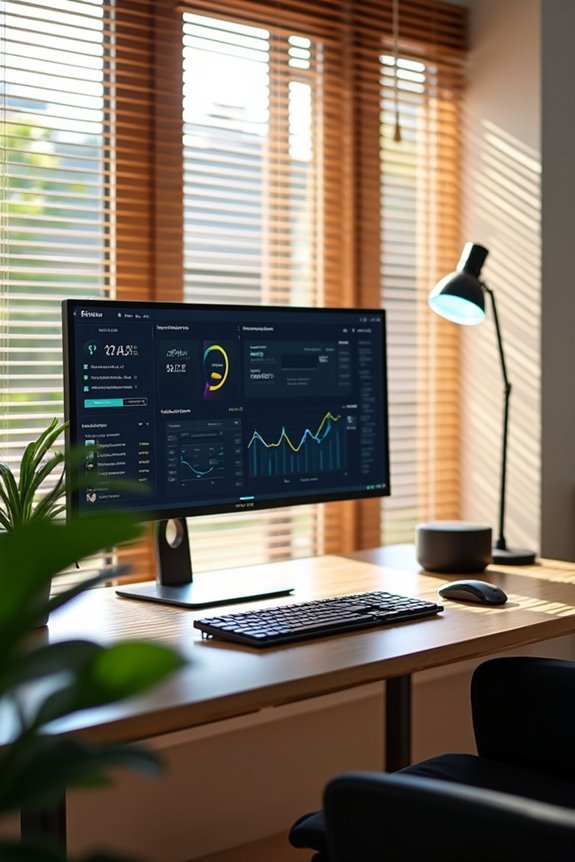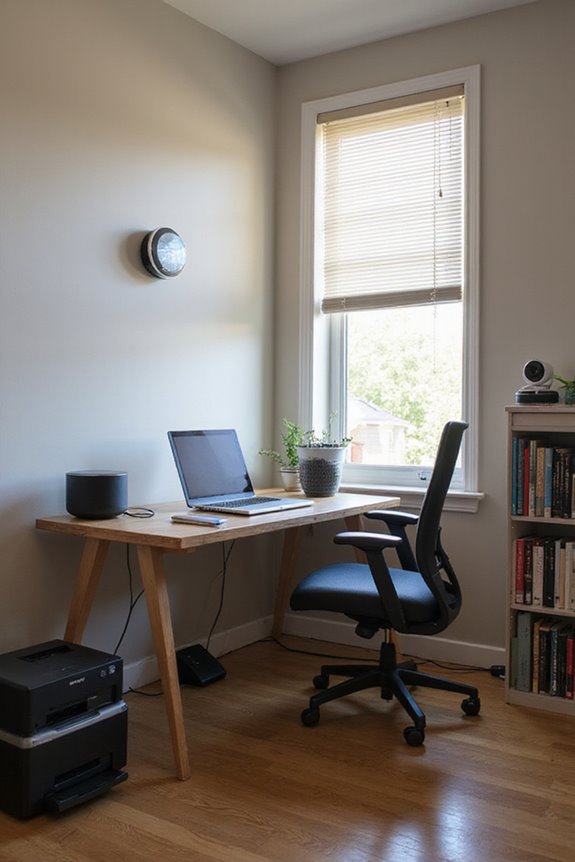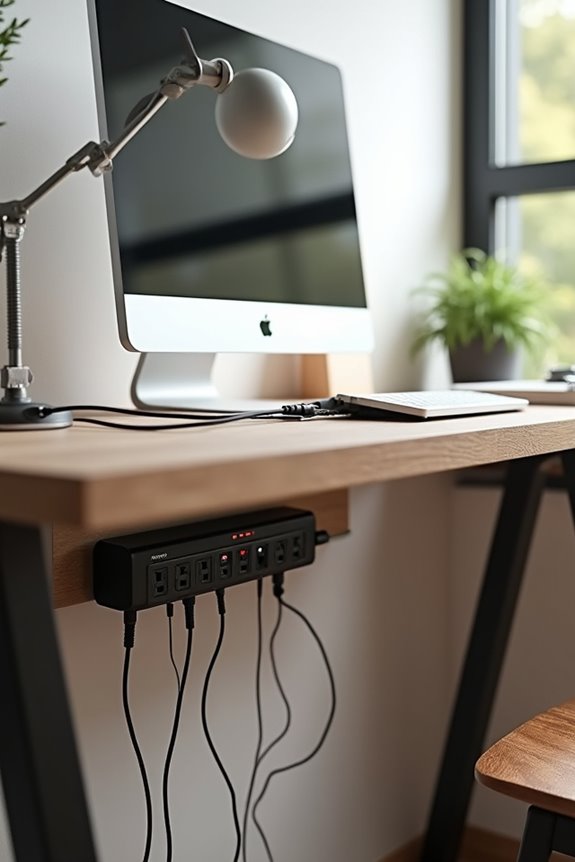Artificial intelligence is changing home office equipment by enhancing efficiency and user experience. Smart equipment integration allows seamless connections between devices, while predictive maintenance can reduce equipment breakdowns by up to 75%, minimizing downtime. AI tailors user experiences by adjusting settings in real-time based on individual preferences and behaviors. Furthermore, automation reduces costs and optimizes resource allocation. Overall, AI brings innovative solutions that promote productivity and sustainability. Explore how these advancements further shape the future of home office technology.
Key Takeaways
- AI will enhance smart equipment integration, allowing seamless connectivity and workflow automation in home offices.
- Predictive maintenance powered by AI will reduce equipment downtime and extend the lifespan of devices.
- Customized user experiences will be created through AI, tailoring ergonomics and workspace setups to individual preferences.
- AI automation will cut labor costs by managing repetitive tasks and optimizing resource allocation.
- Energy-efficient solutions driven by AI will minimize energy consumption and reduce the environmental impact of home office equipment.
Smart Equipment Integration for Enhanced Workflow
As the world of home offices evolves, integrating smart equipment can greatly enhance workflow efficiency. By embracing smart device interoperability, I can connect various systems and tools seamlessly, allowing them to work together. This connectivity streamlines tasks and minimizes the time I spend switching between devices.
Utilizing workflow automation tools is another essential aspect of this integration. These tools enable me to automate repetitive tasks, such as scheduling meetings or managing emails, which ultimately increases my productivity. The ability to customize these smart solutions to my specific needs further enhances my workspace, making it adaptable to changing demands. Overall, the integration of smart equipment not only improves my workflow but also fosters a more organized and efficient home office environment. Furthermore, incorporating advanced data transfer technologies can further optimize the performance of my devices, ensuring that I can work efficiently without delays.
Predictive Maintenance to Reduce Downtime

In today’s fast-paced work environment, minimizing downtime is essential for maintaining productivity, especially in a home office setting. Predictive maintenance offers a solution by leveraging predictive analytics and real-time equipment monitoring. This approach analyzes data from devices and past service records to identify potential issues before they escalate into significant problems.
One of its key benefits is the potential to reduce equipment breakdowns by 70 to 75%. By scheduling maintenance during ideal times, I can keep my workflow uninterrupted, thereby extending the lifespan of my equipment by up to 20%. As the predictive maintenance market continues to grow, integrating these technologies into my home office will likely save time, money, and enhance overall reliability, making my work experience smoother.
Customized User Experiences Tailored to Individual Needs

When it comes to enhancing my home office, the integration of AI offers a remarkable opportunity to create customized user experiences that cater specifically to my needs. AI analyzes my user behavior, enabling the development of personalized ergonomics that enhance my comfort and productivity. For instance, smart desks can adjust in real-time based on my posture, guaranteeing I maintain ideal alignment while I work.
Additionally, AI provides tailored recommendations for my workspace setup, considering my preferences and work habits. This guarantees that every aspect, from chair height to lighting, aligns with my individual requirements. As AI continuously learns from my interactions, it refines these personalized adjustments, ultimately enhancing my overall work experience and well-being. Moreover, incorporating features like adjustable height desks can further promote better posture and productivity throughout my workday.
Adaptive Learning Systems for Continuous Improvement

Given the rapid evolution of technology, adaptive learning systems have emerged as an essential component in enhancing both personal and professional development. These systems utilize adaptive assessments to tailor learning experiences, ensuring that content aligns with individual needs. By continuously tracking progress and providing personalized analytics, they create customized learning paths that keep us engaged and focused on areas needing improvement.
Real-time feedback helps optimize our learning pace, while AI-driven recommendations guide us toward targeted resources. This data-driven approach not only enhances our understanding but also fosters continuous improvement. As remote work becomes more prevalent, integrating these adaptive tools with home office equipment can revolutionize how we approach skill development, making learning more efficient and effective for everyone.
Innovative Design and Functionality in Home Office Gear

As we embrace the benefits of adaptive learning systems, it’s important to recognize how innovative design and functionality in home office equipment can further enhance our work environment. The focus on ergonomic advancements guarantees that our furniture and tools minimize fatigue and improve comfort during long work hours. Additionally, modular designs allow us to customize our setups easily, adapting our spaces to fit evolving needs. AI-powered systems are also making strides in creating personalized workspaces, optimizing lighting and equipment based on our preferences. This integration of smart technology not only enhances usability but also promotes sustainable materials, assuring that our home office gear is eco-friendly. These innovations collectively transform our workspaces into efficient and enjoyable environments. Furthermore, incorporating adjustable lumbar support into furniture design can greatly enhance user comfort and promote better posture during extended periods of sitting.
Impact on Productivity and Operational Efficiency

While the integration of AI in home office equipment may seem like a futuristic concept, it’s already having a profound effect on productivity and operational efficiency in our daily work routines. AI Task Management tools are allowing us to automate scheduling, email sorting, and even data entry. This automation results in time savings, enabling us to focus on higher-value tasks.
Moreover, AI enhances Workflow Optimization by providing real-time assistance and streamlining repetitive processes. For instance, I’ve noticed that using AI tools can boost productivity by an average of 66%. This increase in task throughput means I can handle more inquiries or complete more documents in less time, ultimately transforming how I approach my daily workload.
Cost-Effective Solutions Through AI Automation

In today’s fast-paced work environment, leveraging AI automation can greatly enhance cost-effectiveness in home office operations. By automating repetitive tasks like data entry and document processing, I can notably reduce labor costs while maintaining accuracy. This leads to fewer errors and minimizes the costs associated with rework.
AI budgeting tools aid in performing extensive cost analysis, ensuring optimized resource allocation and preventing unnecessary expenses. Additionally, predictive maintenance models can identify potential equipment failures before they occur, further reducing repair costs. With smart inventory management, AI optimizes office supply levels, preventing waste. Overall, embracing AI automation can lead to operational cost reductions of 20-30%, empowering my home office to function more efficiently and economically.
The Role of AI in Promoting Sustainability in Home Offices

The integration of AI into home office setups isn’t just about increasing efficiency; it also plays an essential role in promoting sustainability. AI-driven systems enhance energy efficiency by monitoring real-time energy use for lighting, heating, and cooling. These automated controls adjust settings based on occupancy, minimizing wasted energy. Additionally, smart sensors collect data on room conditions, allowing IoT devices to optimize climate control.
Moreover, AI supports sustainable practices by identifying eco-friendly materials for office equipment and suggesting timely maintenance, which extends product lifespan. Predictive analytics track emissions and provide feedback to reduce carbon output. By integrating these technologies, we can create a more sustainable home office environment while lowering utility costs and environmental impact.
Frequently Asked Questions
How Will AI Affect the Lifespan of Home Office Equipment?
I believe AI’s impact on the lifespan of home office equipment will be significant. With smart maintenance and predictive analytics, I can anticipate issues early, ensuring my devices last longer and perform efficiently.
What Security Measures Does AI Implement for Home Office Devices?
Imagine a vigilant knight guarding my home office. AI wields facial recognition and data encryption, ensuring only trusted allies enter. With real-time alerts and constant vigilance, it transforms my workspace into a secure fortress.
Can AI Help With Remote Troubleshooting of Home Office Equipment?
I’ve found AI incredibly helpful for remote assistance, quickly diagnosing issues. With predictive maintenance, potential problems are flagged before they escalate, ensuring my home office equipment runs smoothly and minimizing downtime.
How Does AI Influence the Pricing of Home Office Products?
I’ve noticed AI really influences pricing through dynamic pricing models and demand forecasting. As demand for smart features increases, vendors adjust prices accordingly, making AI-integrated home office products often more expensive, but potentially more valuable.
What Role Does User Feedback Play in AI Equipment Development?
You know what they say, “The customer is always right.” That’s why I believe user feedback is essential in AI equipment development; it drives product improvement, ensuring our tools truly meet our needs and preferences effectively.





